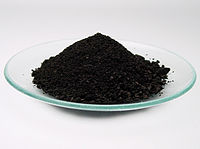
Photo from wikipedia
AbstractIn this work, PtCl4 as precursor; sodium borohydride (Cat I), hydrazinium hydroxide (Cat II), and formaldehyde (Cat III) as reducing agents; and 1-heptanamine (a), N-methyl-1-heptanamine (b), and N,N-dimethyl-1-heptanamine (c) as… Click to show full abstract
AbstractIn this work, PtCl4 as precursor; sodium borohydride (Cat I), hydrazinium hydroxide (Cat II), and formaldehyde (Cat III) as reducing agents; and 1-heptanamine (a), N-methyl-1-heptanamine (b), and N,N-dimethyl-1-heptanamine (c) as surfactants were used to prepare platinum nanoparticles which were then dispersed on carbon XC-72 for use as catalysts in the methanol oxidation reaction. XRD and TEM results indicate that the platinum has a face-centered cubic structure and is found as small and agglomerated particles in different shapes, sizes, and densities. Cat I comprises small (~ 5 nm) cubic and formless agglomerated (~ 20–~ 300 nm) particles, Cat II is composed of small (~ 5 nm) and a significant number of quite dense spherical agglomerated (~ 20–~ 150 nm) particles, and Cat III contains large number of small (~ 5 nm) and a small number of spherical, less dense, and agglomerated (~ 20–~ 200 nm) particles. XPS data shows that the platinum exists in two different oxidation states Pt(0) (~ 64.5–~ 69.6%) and Pt(IV) (~ 35.5–~ 30.4%), and platinum surface also contains OH, H2O, C–O, C=O, and carbon. DFT and FTIR show that the surfactants decompose to form partially crystalline carbon. Electrochemical studies reveal that performance order of the catalysts towards the methanol oxidation reaction is Cat II < Cat I < Cat III, and that Cat IIIc has the highest performance, which is 2.23 times larger than E-TEK catalysts. It was found that the performance of the catalysts depends on the kind of surfactant, reducing agent, electrochemical surface area, percent platinum utility, roughness factor, and If/Ir ratio. Graphical abstractᅟ
Journal Title: Journal of Nanoparticle Research
Year Published: 2017
Link to full text (if available)
Share on Social Media: Sign Up to like & get
recommendations!